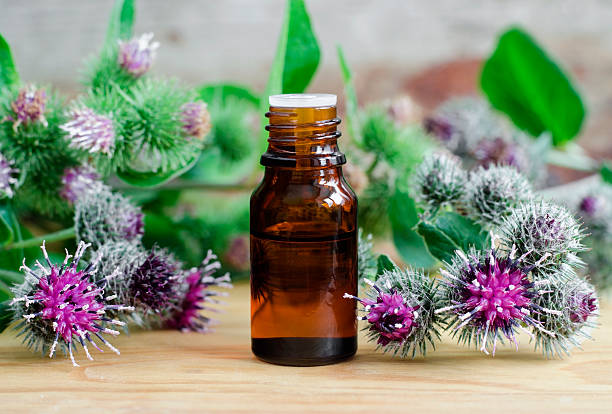Burdock oil has gained a tremendous reputation in recent years, and we've incorporated it into our routines for very good reasons.
This vegetable oil, extracted from burdock root by cold pressing or oily maceration, is famous for its sebum-regulating action, its richness in essential fatty acids, and its powerful antioxidant effect.
Thanks to its versatility, burdock oil has become a go-to ingredient in burdock shampoo, facial serums, hair treatments, and even cleansing formulas and natural supplements.
Its ability to adapt to such diverse formats and its multiple properties make it an infallible ally for caring for our bodies in a healthy and environmentally friendly way.
Burdock: Plant description and origin
Burdock is a robust, biennial herbaceous plant that can grow to over a meter in height. Its leaves are alternate, large, and heart-shaped, with pronounced veins and a soft, velvety underside.
This unique structure has earned it the popular nickname “hook bushes” and gave rise to the invention of Velcro.
Although its wild appearance may go unnoticed on paths and field edges, its root is the real star. It is a taproot, fleshy and deep, which can penetrate almost a meter into the soil, absorbing nutrients and water to sustain the plant during the flowering phase.
Native to temperate regions of Europe and Asia, burdock has become naturalized in much of the Americas, Australia, and other areas with humus- or nitrogen-rich soils. It prefers well-drained soils and full sun exposure, although it will also tolerate more shaded soils if they retain a certain amount of moisture.
Known in Japan as gobō and in some parts of Italy and Portugal as garduna, this burdock plant has crossed oceans thanks to its adaptability.
Today it is cultivated both for culinary uses - especially in Japanese and macrobiotic cuisine - and for making cosmetics and supplements. .
How is burdock oil obtained?
One of the oldest ways to use burdock is by macerating its roots in a vegetable oil base.
After several weeks of maceration at room temperature, the preparation is filtered to separate the plant debris, resulting in a “liquid gold” loaded with active compounds.
In the cosmetics industry, cold-pressed organic soybean oil or other plant-based carrier oil is often used as a base for extraction, as it better preserves nutrients, is GMO-free, and offers a light texture on skin or hair.
The resulting oil undergoes fine filtration and sometimes light stabilization with vitamin E before being packaged in opaque bottles that protect the active ingredients from light and heat.
Burdock root is notable for its high content of inulin (up to 50%), polyacetylenes, volatile acids (acetic, propionic, butyric, isovaleric), as well as fatty acids such as lauric, myristic and palmitic, tannins and polyphenolic acids that give it antioxidant activity. In addition, it provides small amounts of essential vitamins (folic acid, riboflavin, pyridoxine, niacin, vitamin E and vitamin C), which help maintain optimal skin and hair health. In traditional medicine, the dried roots contain mucilage, acetylene sulfur compounds, polyacetylenes, and bitter guaianolide. This explains its use as a diuretic, diaphoretic, and blood purifying agent, promoting the elimination of toxins. Finally, its detoxifying and antibacterial properties make it a favorite ingredient for combination or oily skin , helping to regulate sebum secretion and prevent acne breakouts. As a topical oil, it strengthens the scalp and nourishes the hair fiber, providing shine and flexibility without excessive oiliness. It's included in shampoos, conditioners, and tonics to combat dandruff and hair loss. Thanks to its follicle-stimulating action, it strengthens the bulb and helps revitalize even the finest or brittle hair, reducing breakage and frizz. On the skin, it acts as a natural sebum regulator and antiseptic, ideal for oily or acne-prone skin. It soothes irritation, cleanses pores, and leaves a feeling of freshness and deep cleanliness. Furthermore, its purifying and diuretic properties promote the elimination of fluids and toxins at a general level, helping to reduce swelling and feelings of heaviness. For the skin , burdock's properties include an antioxidant effect that delays the appearance of wrinkles and spots. Polyphenolic acids and tannins stimulate cell renewal and improve skin elasticity. In hair , it stimulates growth by improving circulation in the scalp, combats dandruff and regulates oil production, leaving hair stronger and shinier. At the bodily level , its diuretic action helps eliminate excess fluids, while its purifying properties cleanse the blood and relieve the feeling of retention. Furthermore, the inulin present in the root can help regulate blood glucose, and its anti-inflammatory effect relieves rheumatic and joint pain. It is used in sulfate-free burdock shampoos and conditioners, where its extract provides extra nourishment and cleansing to the hair, ideal for those seeking natural cosmetics. On the face, it is used in facial serums, purifying masks, and cleansing gels for combination or breakout-prone skin, thanks to its astringent and antibacterial action. As a body oil, it is incorporated into creams and restorative massage oils, taking advantage of its healing and regenerative properties in irritated or scarred areas. We also find burdock shampoo in anti-dandruff and purifying formulations, perfect for hair with excess oil or flaking. It's common to add a few drops of burdock oil to your regular shampoo or mix it with a base oil, such as cold-pressed organic soybean oil, before washing. We can prepare a pre-shampoo treatment: we distribute the mixture with a gentle massage on the scalp and let it sit for 20 to 30 minutes before rinsing to maximize its penetration. Another option is to create a spray-on hair tonic by combining burdock oil with rosemary water or green tea, and applying it after washing to provide a boost of nutrients. We recommend using it once or twice a week to avoid saturating the hair fiber and keep the scalp balanced. After cleansing your face, apply 2–3 drops of burdock oil to dry skin and massage gently in circular motions until completely absorbed. This method takes advantage of its antioxidant and restorative properties. It is especially useful for acne-prone skin, as it regulates sebum production, fights bacteria, and soothes inflammation, helping to reduce pimples. For a personalized serum, we blend burdock oil with small doses of jojoba or almond oil, creating a light, balanced texture that won't clog pores. Combined with essential oils such as tea tree, it enhances its purifying and antiseptic effect, providing extra freshness to specific outbreaks. For dry or cracked skin, it acts as a natural repairer, promoting the regeneration of the skin barrier and providing deep nourishment. For eczema and dermatitis, its anti-inflammatory action relieves itching and redness, offering immediate comfort to the most sensitive skin . Its healing properties accelerate the recovery of minor wounds and scars, thanks to the synergy between mucilages and polyphenolic acids. Also ideal for sunburns or irritations, it soothes and refreshes, leaving the skin softer and more even. Before using it, it's a good idea to do a patch test, as some people may be allergic to the ingredients in burdock, and its bracts can cause skin irritation. If you are pregnant or breastfeeding, consult your doctor first, as many products containing burdock root warn. Avoid unsupervised ingestion of the oil, as it can enhance its diuretic effect and alter the electrolyte balance in the body. Do not apply the oil to open wounds or sensitive mucous membranes to prevent possible adverse reactions. In short, the burdock plant is a multifunctional ally that has proven its value in both the kitchen and natural cosmetics. Its properties range from purifying and diuretic effects to a gentle regenerative action on skin and hair. Burdock oil, produced by oily maceration, distillation, or cold pressing, offers a concentrate of active compounds with detoxifying, healing, and sebum-regulating properties, perfect for incorporating into our daily routine. From the roots to the burdock shampoo , its versatility allows us to integrate this plant into our beauty and wellness routine in a natural, respectful, and effective way. We encourage you to try burdock oils or shampoos enriched with this extract, always taking precautions and enjoying its many benefits. How to identify good quality burdock oil? Look for labels that say “cold-pressed” or “cold-macerated” and organic certification. Make sure it comes in a dark or amber glass bottle and includes the extraction date or batch number. A soft, earthy aroma, with no trace of rancidity or chemicals, is a sign of a pure, additive-free product. Can I mix burdock oil with other oils or cosmetic ingredients? Yes. Burdock oil works very well with light carrier oils like jojoba or sweet almond, and with essential oils like lavender or tea tree. It is often added to base creams or customized serums to enhance their effects without altering the final texture. Is burdock oil suitable for mature skin or rosacea? Although it has regenerative and soothing effects, we recommend testing a small area first for very sensitive skin or rosacea. If there is no reaction, it can help strengthen the skin barrier; but in severe cases, it's best to consult a dermatologist first. Does it help reduce stretch marks or marks on the skin? Its contribution of fatty acids and antioxidants improves skin elasticity and promotes barrier regeneration. By applying it daily after showering, we'll notice our skin will become more supple and stretch marks will become less noticeable over time.Main properties of Burdock
What is Burdock Oil used for?
Benefits of Burdock on skin, hair and body
Uses of Burdock Oil in Cosmetics
Burdock Oil for Hair: How to Apply It?
Burdock Oil for Face: How to Use It?

Burdock Oil for Skin: What Is It Good For?
Precautions and things to avoid with Burdock Oil
Final Conclusion
Frequently Asked Questions


